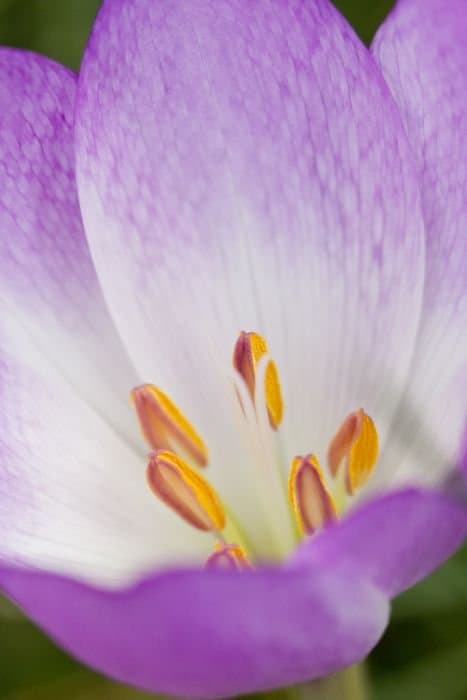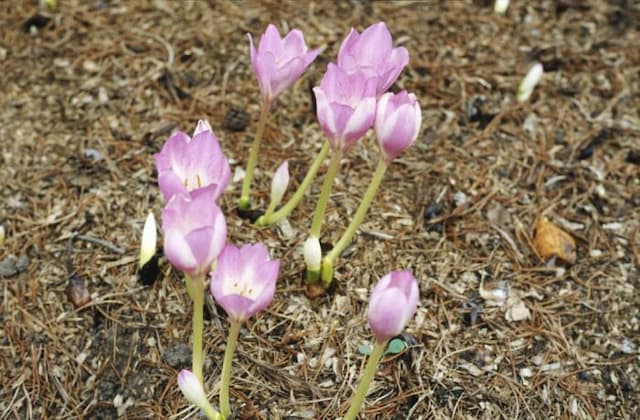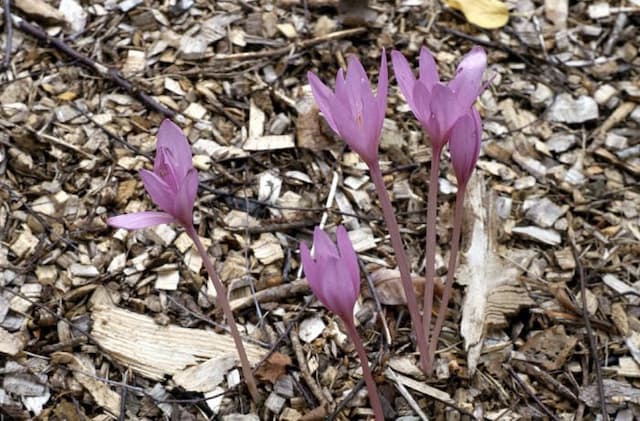Autumn Crocus Colchicum cilicicum

ABOUT
Colchicum cilicicum, commonly known as autumn crocus, is a flowering perennial that produces striking blooms. The flowers of the autumn crocus are noteworthy for their shape and color. They resemble large, goblet-shaped structures and are often a vibrant pink or purple, with a white throat. The blooms have six petals that spread outwards and can sometimes display a checkered pattern. The leaves of the autumn crocus are typically not seen when the flowers are in bloom because the leaves grow in the spring and die back before the flowers emerge in the fall. When present, the leaves are oblong to lance-shaped, glossy green, and have a smooth margin. The plant's foliage might form a clump, which provides a lush backdrop for the flowers when they're not in bloom. The plant produces fruits that are capsules, positioned at the end of a long stem, which only becomes visible after the flowers have withered. The entire plant emerges from a bulb-like structure called a corm, which is nestled under the soil between periods of active growth. The autumn crocus is popular in gardens and as an ornamental plant, particularly appreciated for its bright, showy blooms that add color to the landscape during a time when many other plants are starting to decline.
About this plant
 Names
NamesFamily
Colchicaceae
Synonyms
Cilician Colchicum, Autumn Colchicum
Common names
Colchicum cilicicum, Colchicum troodi, Colchicum kochii
 Toxicity
ToxicityTo humans
Colchicum cilicicum, commonly known as autumn crocus, is highly toxic to humans. All parts of the plant contain colchicine, a potent compound that can be fatal if ingested. Symptoms of poisoning may include gastrointestinal distress such as burning of the mouth and throat, vomiting, diarrhea, and abdominal pain. Severe cases can lead to kidney failure, liver damage, respiratory failure, seizures, and ultimately death. Even small amounts can be dangerous, and medical attention should be sought immediately if ingestion occurs.
To pets
Autumn crocus is also highly toxic to pets, including dogs, cats, and horses. Ingesting this plant can lead to severe symptoms such as gastrointestinal upset, drooling, vomiting, diarrhea, weakness, respiratory difficulties, seizures, and potentially death due to organ failure. It is critical to prevent pets from accessing any part of the plant, and to seek veterinary care immediately if there is any suspicion of ingestion.
 Characteristics
CharacteristicsLife cycle
Perennials
Foliage type
Deciduous
Color of leaves
Green
Flower color
Pink
Height
6 inches (15 cm)
Spread
6 inches (15 cm)
Plant type
Bulb
Hardiness zones
4
Native area
Turkey
Benefits
 General Benefits
General Benefits- Decorative Appearance: Colchicum cilicicum, commonly known as autumn crocus, produces striking, cup-shaped purple flowers that add aesthetic appeal to gardens and landscapes.
- Seasonal Interest: This plant blooms in the fall, providing color and interest during a season when many other plants are starting to decline.
- Easy to Grow: Autumn crocus is known for its ease of care, flourishing in a range of soil types and requiring minimal maintenance once established.
- Naturalizing: It can spread over time to create natural-looking drifts that enhance the beauty of an area with minimal gardener intervention.
- Pollinator Attraction: Autumn crocus flowers can attract bees and other pollinators to the garden, supporting local ecosystems.
- Drought Tolerance: Once established, the autumn crocus is relatively drought-tolerant, making it suitable for dryer climates or water-wise gardens.
- Deer and Rodent Resistance: Typically, the plant is not favored by deer or rodents, which helps to reduce damage from garden pests.
- Compact Growth: With its compact size, it is well-suited for borders, rock gardens, and container planting.
- Propagation Ease: Colchicum cilicicum can be propagated by dividing corms, allowing gardeners to easily spread the plant to other areas or share with others.
 Medical Properties
Medical Properties- Anti-inflammatory: May be used to reduce inflammation.
- Analgesic: Acts to relieve pain.
- Antitumor: Has been studied for potential effects against certain types of tumors.
- Cytotoxic: Possesses cell-damaging properties that may be harnessed for anti-cancer therapies.
- Antifungal: Shows activity against certain fungal pathogens.
- Antimitotic: Can interfere with cell division, which is why it's used in the treatment of gout (although not recommended without medical supervision).
- Alkaloid rich: Contains colchicine, which is known for its medicinal properties.
 Air-purifying Qualities
Air-purifying QualitiesThis plant is not specifically known for air purifying qualities.
 Other Uses
Other Uses- Colchicum cilicicum bulbs contain chemicals that can be used to deter pests and insects from gardens and homes.
- The plant's large, showy flowers are sometimes used in botanical art or photography due to their striking appearance.
- Extracts from the plant are used in dyes for textiles, providing a range of colors from yellow to brown.
- Cultivars of Colchicum cilicicum are prized in ornamental horticulture for their ability to naturalize and provide autumn color.
- The dried flowers of the plant have been used in potpourri mixes, adding a floral note to the aromatic blend.
- The leaves of the plant are sometimes incorporated into floral arrangements and plant crafts for aesthetic purposes.
- Due to its toxicity, the plant has been used historically as a component in rodent poisons.
- In some regions, agriculturalists may use the plant as an indicator species to signify specific soil conditions like drainage or pH levels.
- The distinct shape and structure of Colchicum cilicicum corms have been studied and mimicked in biomimicry applications, particularly in designs that require compartmentalization.
- The plant's ability to bloom in the fall offers educational opportunities in botany and horticulture classes focused on plant life cycles and phenology.
Interesting Facts
 Feng Shui
Feng ShuiThe autumn crocus is not used in Feng Shui practice.
 Zodiac Sign Compitability
Zodiac Sign CompitabilityThe autumn crocus is not used in astrology practice.
 Plant Symbolism
Plant Symbolism- Rebirth: Colchicum cilicicum, commonly known as autumn crocus, often symbolizes new beginnings or renewal because it blooms in the fall when most other plants are dying or going dormant.
- Endurance: This plant emerges and flourishes at a time when the environment is becoming less conducive for growth, representing the ability to persevere through challenging conditions.
- Patience: The autumn crocus has a unique growth cycle in which the leaves and seeds develop and die back in the spring, but the flowers don't appear until fall, representing the virtue of patience and the reward of waiting.
- Mystery: Given its unexpected blooming time and the fact that it can be poisonous, autumn crocus also represents mystery and caution, as its beauty can be deceiving.
 Water
WaterAutumn crocus plants require minimal watering since they are drought-tolerant. During the growing season in the fall, water them lightly to moderately, ensuring the soil is moist but not waterlogged, approximately once a week depending on the weather conditions. When the plant is dormant, especially in the summer months, watering should be very sparing or even unnecessary unless the weather is exceptionally dry. A good rule of thumb is to provide about 1 inch of water every week or two during their active growth period. Always check the topsoil for dryness before watering.
 Light
LightAutumn crocus thrives in full sun to partial shade. The ideal spot for this plant is an area that receives morning sunlight and is shaded during the hottest part of the day. They can also tolerate full shade, but blooming may not be as prolific. Avoid placing them in areas with intense, direct afternoon sunlight, as this can stress the plants.
 Temperature
TemperatureAutumn crocus prefers temperate climates and can tolerate a wide range of temperatures. They can survive temperatures as low as 10 degrees Fahrenheit in winter dormancy. The ideal temperature range during their growing season in the fall is between 50 and 70 degrees Fahrenheit, while during their dormant period in summer, they can handle temperatures above 80 degrees Fahrenheit. The plants are hardy and resilient to varying temperatures, but extreme cold or heat for extended periods may be harmful.
 Pruning
PruningAutumn crocus generally requires little to no pruning. Deadheading or removing spent flowers after they bloom can encourage the plant's energy to be redirected into the corm for the next season, but it's not essential. If leaves or stems become damaged or diseased, they can be trimmed away to maintain plant health. The best time for any pruning is after the foliage has yellowed and died back naturally, typically in late spring.
 Cleaning
CleaningNot needed
 Soil
SoilAutumn Crocus (Colchicum cilicicum) thrives in well-draining, fertile soil with a neutral to slightly alkaline pH, around 6.5 to 7.5. A soil mix consisting of equal parts loam, sand, and compost or well-rotted manure will provide the nutrients and drainage necessary for healthy growth.
 Repotting
RepottingAutumn Crocus should be repotted every 3 to 4 years, or when the corms become overcrowded. The best time to repot is after the leaves die down in late spring or early summer.
 Humidity & Misting
Humidity & MistingAutumn Crocus prefers average to low humidity levels. As a bulbous plant, it does not require high humidity and can thrive in the humidity levels typically found in temperate environments.
 Suitable locations
Suitable locationsIndoor
Place in bright, indirect light and ensure good air circulation.
Outdoor
Plant in full sun to partial shade; ensure soil is well-drained.
Hardiness zone
4-9 USDA
 Life cycle
Life cycleColchicum cilicicum, commonly known as autumn crocus, begins its life cycle as a seed planted in well-drained soil during spring. The seed germinates and develops into a bulb, which remains dormant underground during the hot summer months while the foliage dies back. In early autumn, the plant breaks dormancy and produces a leafless flower stalk bearing a single, showy, pink to purple bloom, capitalizing on the cooler temperatures and autumn rains. After flowering, the autumn crocus produces leaves that photosynthesize through the winter and spring, enabling the bulb to store energy. As temperatures rise in late spring, the foliage again withers and the plant enters a period of summer dormancy. Throughout its lifecycle, the autumn crocus bulb may also reproduce vegetatively by producing offsets, gradually forming a clump of flowering plants.
 Propogation
PropogationPropogation time
Fall
Colchicum cilicicum, commonly known as autumn crocus, is typically propagated through division of its corms, with the ideal time for this being when the plant is dormant, generally in the late summer. The process involves carefully digging up the mature corm and separating the smaller cormlets that have formed around the base. These cormlets are then planted about 3 inches deep (approximately 7.6 centimeters) and spaced approximately 6 inches apart (about 15.2 centimeters) in well-draining soil with some exposure to sunlight. Watering should be moderate until growth is observed, after which the plant can be treated per usual care instructions. This method of propagation is straightforward and allows the gardener to expand their collection or rejuvenate older clumps that have become too dense.









